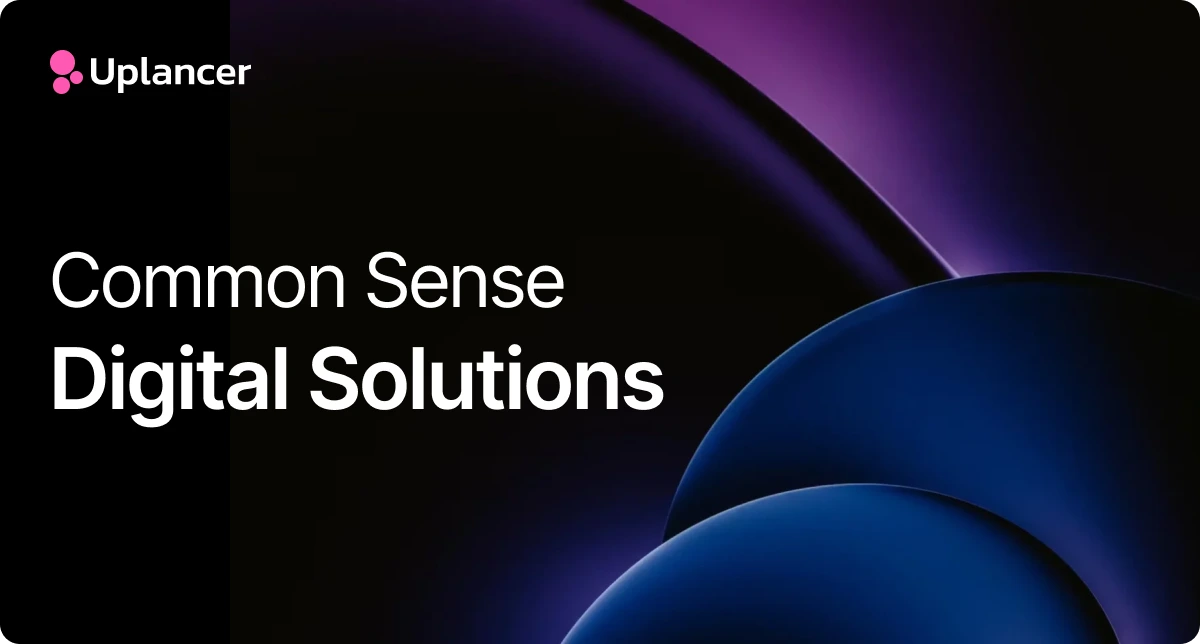Educate, Engage, Convert: Unveiling the Power of Middle-of-the-Funnel Marketing

In the evolving world of digital marketing, businesses are constantly seeking innovative strategies to reach their target audience. While top-of-the-funnel (ToFu) and bottom-of-the-funnel (BoFu) marketing tactics are well-known, middle-of-the-funnel (MoFu) marketing often remains a hidden gem. In this blog we will be exploring its importance, strategies, and its potential to engage and convert audiences of all age groups.
Understanding the Marketing Funnel

The marketing funnel is a visual representation of the customer journey, from initial awareness to conversion. It’s divided into three main stages: top-of-the-funnel (ToFu), middle-of-the-funnel (MoFu), and bottom-of-the-funnel (BoFu). Each stage has a specific focus and plays a crucial role in guiding prospects towards making a purchase.
- Top-of-the-Funnel (ToFu): This is the awareness stage where potential customers first become aware of your brand or product. The goal is to capture their attention and make a positive first impression.
- Middle-of-the-Funnel (MoFu): In this stage, leads are interested and looking for more information. Your goal is to nurture them and provide valuable content to address their needs and concerns.
- Bottom-of-the-Funnel (BoFu): At the bottom of the funnel, leads are ready to make a purchase decision. Your focus is on converting them into paying customers through tailored offers and incentives.
MoFu marketing is often overlooked but is essential for moving prospects from consideration to conversion. It’s the stage where relationships are built, trust is established, and leads are educated about the value your product or service offers.
Middle-of-the-Funnel (MoFu) Marketing
Middle-of-the-funnel marketing, often referred to as MoFu marketing, is a critical phase in the marketing funnel where potential customers have moved beyond the initial awareness stage (ToFu) and are considering their options before making a purchasing decision (BoFu). MoFu marketing focuses on nurturing leads, building relationships, and providing valuable information to guide prospects through the decision-making process.
Importance of MoFu Marketing
MoFu marketing is the bridge that connects awareness to conversion. It’s the stage where leads are educated, engaged, and prepared to make informed decisions. Neglecting MoFu marketing can result in lost opportunities and potential customers dropping out of the sales funnel prematurely.
MoFu marketing is versatile and effective for engaging audiences of all age groups. Whether you’re targeting tech-savvy millennials or a more traditional audience, MoFu strategies can be tailored to suit different demographics.
The Role of MoFu Marketing
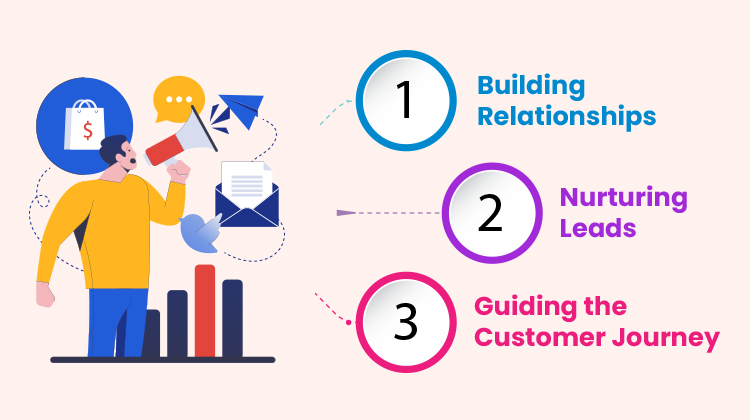
Middle-of-the-Funnel (MoFu) Marketing is a pivotal stage in the marketing funnel that plays a unique and crucial role in the customer journey. Let’s delve deeper into the significance of MoFu marketing and understand how it drives success in your marketing strategy.
Building Relationships
- Content that educates and informs: In the MoFu stage, your audience seeks detailed information to make informed decisions. MoFu content should offer valuable insights that address specific pain points and questions, positioning your brand as a trusted source of expertise.
- Establishing trust and credibility: MoFu is where trust is cultivated. Consistently delivering high-quality content that aligns with their needs builds trust, easing doubts and encouraging leads to move forward.
Nurturing Leads
- Importance of lead nurturing: Recognize that leads require time and information before converting. MoFu involves personalised communication and content to keep leads engaged and build relationships.
- Personalization in MoFu marketing: Tailor content to individual preferences and behaviours. Personalization enhances the relevance of interactions, increasing the likelihood of conversion.
Guiding the Customer Journey
- Moving prospects closer to conversion: MoFu content guides prospects through consideration, addressing evolving needs. Different stages require different information to support decision-making.
- Aligning content with customer needs: Successful MoFu marketing understands customer pain points. Providing the right content at the right time guides leads toward conversion.
In short, MoFu marketing builds relationships, nurtures leads, and guides them toward conversion. By focusing on education, trust-building, personalization, and aligning content with customer needs, you can leverage MoFu’s power to enhance conversion rates and establish enduring customer relationships.
Content Strategies for MoFu Marketing
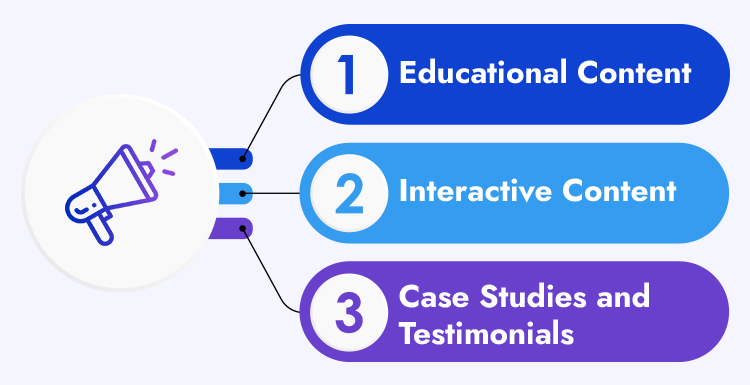
In the Middle-of-the-Funnel (MoFu) stage, your content strategy should be finely tuned to provide the right information and engagement to leads who are actively considering their options. Here, we’ll explore effective content strategies tailored for MoFu marketing.
Educational Content
- Blog Posts: Maintaining a blog is a versatile way to provide educational content in the MoFu stage. Create in-depth articles that dive into specific topics related to your industry or product. These should not only educate but also position your brand as an authoritative source. Address common pain points, challenges, and frequently asked questions that your leads might have.
- How-to Guides: Comprehensive how-to guides and tutorials are highly valuable in the MoFu stage. They demonstrate your expertise and showcase how your product or service can be applied to solve specific problems. Ensure these guides are well-structured, easy to follow, and rich in visuals.
Interactive Content
- Quizzes and Surveys: Interactive content like quizzes and surveys can engage leads while collecting valuable data about their preferences and needs. Create quizzes that help leads assess their requirements or surveys that seek their opinions on industry trends. Use the data collected to personalise future interactions.
- Webinars and Workshops: Hosting live or on-demand webinars and workshops allows you to engage directly with leads. These sessions can cover topics of interest or provide in-depth insights into your product or service. Encourage audience participation through Q&A sessions and polls. Webinars also offer an opportunity for real-time engagement and questions, fostering trust and relationships.
Case Studies and Testimonials
- Real-Life Success Stories: Share case studies that highlight real-life success stories of customers who have benefited from your product or service. These stories add a human element to your brand and provide concrete evidence of the value you offer. Case studies should be well-documented, featuring data and testimonials from satisfied customers.
- Social Proof in MoFu Marketing: Testimonials and reviews are powerful forms of social proof. Incorporate testimonials into your content, especially when addressing common objections or concerns of leads. Encourage satisfied customers to share their experiences, and display these prominently on your website and in your marketing materials.
Effective MoFu content strategies should aim to educate, engage, and address the specific needs and questions of leads who are actively considering their options. By providing valuable, informative content, leveraging interactive elements, and showcasing real-world success stories, you can foster trust, nurture relationships, and guide your leads toward the final conversion stage.
Engagement Tactics for All Age Groups
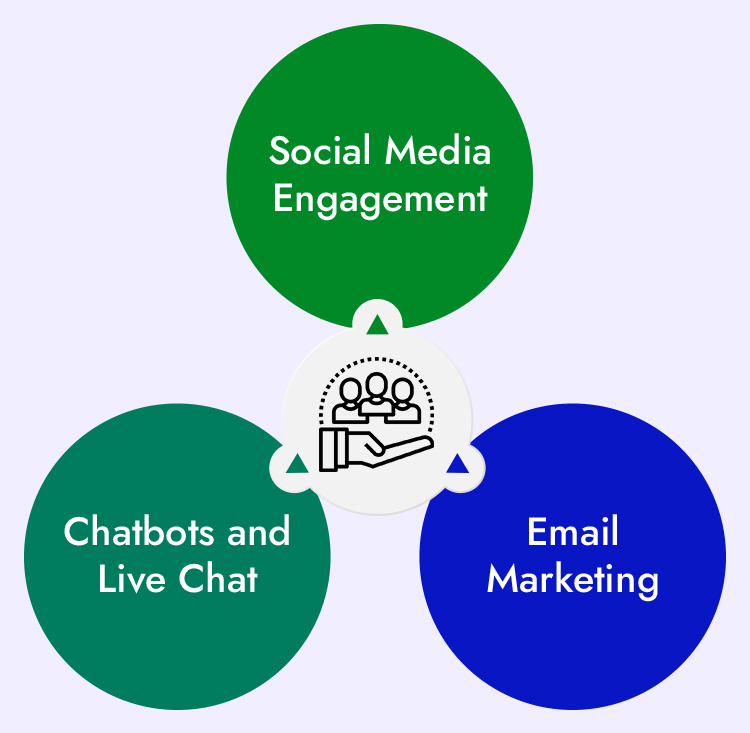
Engaging with your audience effectively in the Middle-of-the-Funnel (MoFu) stage requires a strategic approach that resonates with individuals of all age groups. Here, we’ll explore engagement tactics tailored to different demographics.
Social Media Engagement:
Social media remains a powerful platform for engagement, but the choice of platforms can vary significantly depending on your target age group. For younger audiences, platforms like Instagram and TikTok may be more effective, while older demographics may lean toward Facebook and LinkedIn. Tailoring your social media strategy to your audience’s preferred platforms ensures your message reaches them where they are most active.
Email Marketing:
Email remains a versatile and reliable channel for engagement. The key to success in MoFu marketing is personalization. Segment your email list based on demographics and behaviours to deliver content and offers that are relevant to each age group. Effective subject lines and content that addresses specific needs and interests are essential for engaging leads of all ages.
Chatbots and Live Chat:
Instant customer support through chatbots and live chat features can be a game-changer for engagement. These tools provide immediate responses to queries, enhancing the user experience. To cater to different age groups effectively, tailor the interactions based on the preferences and expectations of each demographic. Younger generations may prefer chatbots for quick, text-based assistance, while older audiences may appreciate the option for live chat with a human agent.
Measuring MoFu Marketing Success
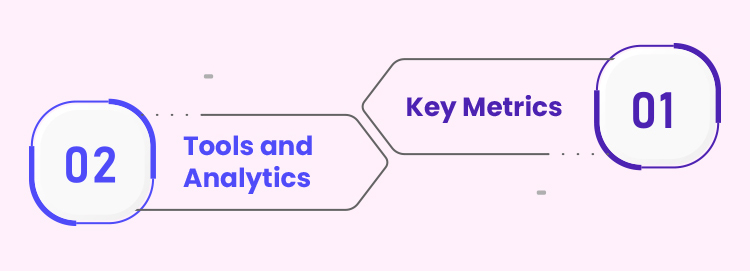
Measuring the success of your Middle-of-the-Funnel (MoFu) marketing efforts is essential to refine your strategies and optimise results. Let’s explore the key aspects of measuring MoFu marketing success.
Key Metrics:
Tracking specific metrics provides insight into the effectiveness of your MoFu campaigns. Metrics such as click-through rates (CTR) gauge the engagement level of your content. CTR indicates how successful your content is at encouraging leads to take the next step. Engagement rates, which encompass likes, shares, comments, and other interactions, help you understand how your content resonates with your audience. Lead progression is a vital metric that tracks how leads move through the MoFu stage, providing a clear picture of conversion readiness.
Tools and Analytics:
Utilising analytics platforms and tools is crucial for data-driven decision-making. Platforms like Google Analytics and marketing automation software offer in-depth insights into user behaviour, content performance, and lead progression. By regularly analysing this data, you can identify trends, strengths, and areas for improvement in your MoFu marketing strategy. Furthermore, analytics help you understand which content types and channels are most effective in engaging leads.
Tips for Implementing MoFu Marketing
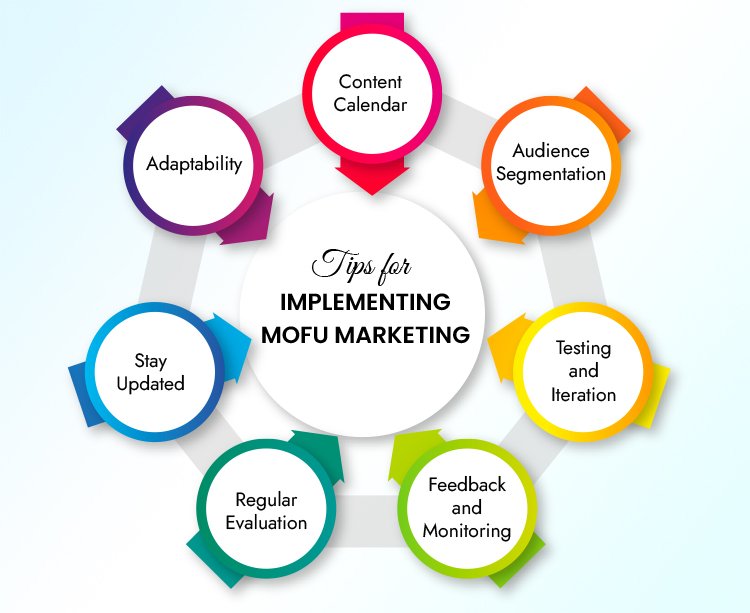
Implementing Middle-of-the-Funnel (MoFu) marketing successfully requires a strategic and well-executed approach. Here are some valuable tips to consider when integrating MoFu strategies into your overall marketing efforts.
- Content Calendar: Develop a dedicated content calendar for MoFu marketing. This schedule ensures consistent, relevant content to nurture leads.
- Audience Segmentation: Segment your audience based on data, tailoring content to specific needs and preferences.
- Testing and Iteration: Continuously A/B test content and engagement tactics, refining your strategies based on what works best.
- Feedback and Monitoring: Encourage feedback from leads and customers. Use surveys and social listening to gather insights.
- Regular Evaluation: Monitor key metrics like engagement rates and lead progression to gauge campaign effectiveness.
- Stay Updated: Stay current with evolving trends and technologies in MoFu marketing to remain effective.
- Adaptability: Be flexible and adapt to changing consumer behaviour and preferences to ensure continued success.
Conclusion
In the dynamic realm of modern marketing, Middle-of-the-Funnel (MoFu) marketing emerges as a beacon of success, offering a path to nurture relationships, build trust, and ultimately drive conversions. Throughout this comprehensive guide, we’ve uncovered the key elements and strategies that make MoFu marketing so potent. It’s not just a phase but a crucial bridge that connects potential customers to the final decision-making stage. Whether you’re a seasoned marketer or just starting out, the principles of MoFu marketing are universally applicable. By embracing education, engagement, and guidance, you can pave the way for turning prospects into devoted customers.
